Article and all photos by Joe Mock, BaseballParks.com
All rights reserved
“What you’re looking at connects the past of the City with the future of the City.”
Considering that this statement came from a city’s mayor, you might think it’s simple hyperbole. But when it comes from Stephen Benjamin of Columbia, SC, and he’s referring to the city’s new baseball palace and all of the potential that lies in the land around it, it’s easy to catch a glimpse of his vision.
| Ballpark Stats |
 |
| Team: Columbia Fireflies of the Low-A South Atlantic League |
| First game: April 14, 2016, a 4-1 win over the Greenville Drive |
| Capacity: 8,500, including 6,000 fixed seats, 16 luxury suites and four concourse suites |
| Architects: Populous |
| Construction: CCEB |
| Price: $37 million |
| Home dugout: 3B side |
| Field points: east by southeast |
| Playing surface: Tifway 419 Bermudagrass |
| Betcha didn’t know: the historic building retained next to the park’s ticket office was used as the morgue for the state mental hospital |
Spirit Communications Park, which opened April 14, 2016 under cloudy South Carolina skies, is the home of the Columbia Fireflies of the Low-A South Atlantic League. The franchise made the 166-mile move north from Savannah, GA to Columbia following the 2015 season. The Sand Gnats, as they were called, departed Savannah for the same reason that Columbia had been without affiliated Minor League Baseball until now: the lack of an adequate ballpark.
“The decision to move was a tough one,” John Katz, the team’s president, told me. “Savannah has a rich baseball history, and we didn’t want to leave. Over a six-year period, we stood by our promise to do everything we could to stay in Savannah, but it got to a point from a facilities standpoint where it was hard to run a baseball business there.”
Indeed, 90-year-old Grayson Stadium was anything but state-of-the-art. “There were days when the Internet for our entire stadium would go down because squirrels had chewed through the wires,” Katz noted.
The franchise’s ownership made the decision to move when they felt they had no viable option to stay in Savannah. “There was no appetite from a political standpoint for either a new ballpark or a rebuilding of Grayson Stadium,” he said.
Interestingly, the same series of events occurred in Columbia – minus the voracious squirrels, one assumes. The franchise known for 10 years as the Columbia Mets (and as the Capital City Bombers for 12 years) fled the market for the promise a new ballpark upstate. By the team’s final season in Capital City Stadium in 2004, the facility had become quite sorry indeed. Today, that franchise is flourishing as the Greenville Drive in Fluor Field, which was our Ballpark of the Year when it opened in 2006.
And although the ironic touch was probably unintended by the schedule makers, the Drive was the opponent when the newly named Columbia Fireflies opened Spirit Communications Park.
So affiliated Minor League Baseball is part of Columbia’s “past” that Mayor Benjamin was referring to in his quote. Ask any market that has lost its team – it wants it back. Those can be lonely years without baseball, as cities like Albuquerque, Sacramento, Fresno and Memphis learned. When I asked Benjamin what the return of baseball means to his city, he became somewhat philosophical. “The importance can’t be overstated,” he pointed out. “Baseball is America’s pastime, and I don’t believe you can be a great American city if baseball isn’t being played there.”
| Darn squirrels |
 |
| This is a 2016 shot of Grayson Stadium in Savannah, where squirrels would sometimes chew through wires, leaving the facility without the Internet. |
The remedy, as other municipalities have learned, is to make a big investment in a new ballpark. That goes a long way toward attracting the national pastime back to your city. In Columbia’s case, the investment was $37 million, and was the centerpiece to an elaborate economic-development project.
That project is well underway, but is expected to take about 20 years to complete. This is the “future of the city” the Mayor likes to talk about.
But there’s more to the “city’s past” to examine, much more than just the return of baseball. The other aspect is truly big – 181 acres big. We’ll examine that in The Setting section of our review.
First, though, let’s look at the financials involved with this ballpark … because when compared with other new parks in recent years, they seem hard to believe.
“When we started working on exactly what the new park was going to look like, we created a wish list of everything we could ever want,” recalled team president John Katz. Since the owners also operate the Fort Wayne TinCaps of the Midwest League, they were able to draw upon their experiences with Parkview Field, which opened in 2009. “We used Populous as the architects there, so we asked them what it would cost to build everything on our wish list in Columbia if there were no budget. They told us, and then they explained what we needed to do to get to our number.”
That number was $37 million. “And we stuck to it,” Katz added. That started the process of refining the exact features, and no matter what weather events occurred and how subcontractor pricing rose, the group involved in the process didn’t let that budget change. Indeed, when the park opened on April 14, 2016 – which was the originally targeted date — the final pricetag was $37 million.
On time. And on budget. And, to me, this is a $50-million-plus ballpark, built for $37 million.
| Playing Hardball |
 |
| The Fireflies — like the Chattanooga Lookouts and the Fort Wayne TinCaps — are owned by Hardball Capital. The principal owner of Hardball is Jason Freier, shown here. His background includes degrees from Harvard and the Yale Law School. He graciously gave of his time on opening day to take me on an exclusive tour of the ballpark. He’s justifiably proud of the facility. |
The team that made this happen involved the City (with the key individual being Gregory Tucker, Special Projects Administrator for Columbia), the Sand Gnats/Fireflies (with owner Jason Freier and president John Katz being present at most of the meetings), CCEB (the consortium of contractors who built the facility), Hughes Development (Bob Hughes) and Populous (Mike Sabatini was the lead designer).
The makeup of the funding is interesting. The City sold bonds totaling $29 million to pay for the construction. Paying off those bonds is revenue from “meal taxes.” “This is a kind of hospitality tax that was already in existence,” Tucker explained. “Any prepared meal in the city carries a 2% tax. Organizations can then apply for the funds to be used for something to promote tourism and the City. In this case, money was designated for the stadium.”
Another $7 million came from the Fireflies franchise. The rest? “Mr. Hughes kicked in $1 million,” said Katz. “That money was used to construct the elaborate entry plaza (for the park), which is truly spectacular.”
Helping all of this is the naming rights for the park. Local employer Spirit Communications agreed to pay $350,000 a year for 10 years, with options to continue the arrangement beyond that. Spirit also provides free WiFi in the park, with over 100 access points scattered around the facility.
But where exactly did they build this pretty ballpark, and how does it tie into the City’s history? Read on to find out.
The Setting

The City of Columbia had an interesting dilemma on its hands. Close to the city’s center, there was a sprawling piece of property that for the past 150 years had a single purpose: act for the betterment of the mentally ill of South Carolina. On this property was a large state mental hospital (I heard many locals refer to it as “the asylum”) and numerous out buildings that supported the effort – including a bakery.
“As the years went by, attitudes about the way to treat the mentally ill changed,” Tucker noted. “Eventually, the campus concept went by the wayside, and the State was left with a large campus with lots of abandoned buildings.”
By 2005, the South Carolina Department of Mental Health decided they no longer needed or wanted the property, so they declared that they would like to sell the 181-acre campus. That was easier said than done, as various legal challenges were raised about exactly where the proceeds of the sale should go. After almost two years, the Supreme Court of the State ruled that the sale could move forward.
The State hired a local company to attempt to sell the property. Two years later, they and Hughes Development of Greenville, SC agreed to a contract that would put 165 of the acres under Hughes’ control. The Hughes proposal was attractive because it involved developing the campus for residences, office space and commercial use.
This began a lengthy approval process that included the State Budget and Control Board (who approved the sale in June of 2011) and Columbia City Council.
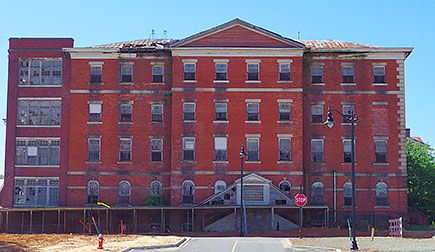 |
| This is the Babcock Building, the main hospital facility when the campus was strictly for treating the mentally ill. |
The Mayor patiently outlined for me the arduous process the city went through. “There was certainly aggressive opposition to the plan,” including two votes in the City Council that were 4-3. What carried the day, though, was a thorough feasibility study on what was likely to happen if the city were to be involved in a large development project that would include a ballpark. “The numbers spoke for themselves. The economic impact would be stunning, enough so that we could change the future of the city.”
Stunning? You be the judge: the study from Miley and Associates projected that once the project was built out, the labor income there would hit $581 million. A year. They predicted 11,000 new jobs would be created and the total economic impact would be $1.2 billion. And for those of you who say public projects for rich developers never give anything back to the taxpayers, the study stated that the additional property taxes going to the school systems and local government would be $20 million.
In October of 2012, the Council approved the overall development plan, which came to be called The Commons at BullStreet (yes, there’s no space between Bull and Street), and in July of the following year, they formally named Hughes to be the master developer. Construction began in earnest early in 2015 … almost exactly ten years after the State first announced that it wanted to sell the property.
Where does the ballpark come in? That was the centerpiece of it all. The construction of a first-class baseball stadium showed that this was a truly earnest project, in that the rest of the development action would emanate from it.
So where in the campus did the developer want the ballpark to be built? He left it to the experts – and told them that they could have the land for free. “We had the freedom to select the exact spot,” Tucker recalled. “So we asked (Bob) Hughes, ‘Well, how much land are you donating?’ He came back and said, ‘Let’s try this. You design exactly what you want, then we’ll draw the property line around it.’ It was truly the generosity of the developer who made this happen, because he wanted us to have everything we wanted, then he would set the (property) boundary for the park.”
The team, the City and Populous agreed on a site about two blocks from Bull Street on the western edge of the campus, about a block north of the Babcock Building, which was the original mental hospital.
Speaking of that building, there was a lot of discussion about what, if any, of the buildings on the campus would remain, since they were all both abandoned and crumbling. But that didn’t make them unimportant, especially since the history of the site included a prison camp for Union soldiers during the Civil War and a separate annex with a mental hospital for African American patients, according to Mayor Benjamin.
“Early on, there were those who feared that we’d lose buildings with historic significance,” he told me. “But now, they are all proponents of what we’re doing, because every historic building is being repurposed.”
Hughes worked with the Columbia Historical Society on which buildings to preserve, and they initially selected five, including the stunning Babcock Building, the campus’ bakery and the morgue.
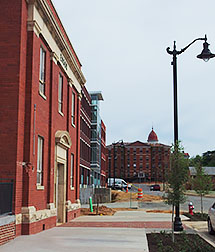 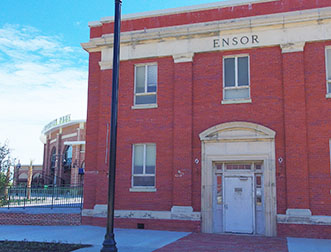 |
| The Ensor Building is a fascinating structure. Not only was it deemed historically and architecturally important, its location and layout lends itself beautifully to house both a restaurant and offices. It is also directly adjacent to the ballpark’s ticket offices and merchandise store. |
The morgue, also called the Ensor Building, stands adjacent to the ballpark’s ticket windows and store. When it is fully refurbished, there will be a restaurant on the ground level and office suites above it.
A brand-new building has been constructed along the ballpark’s right-field foul line. Cleverly called the First Base Building, the structure offers 114,000 square feet of office space. Its first tenants were about to move in as the park opened. This building is directly in between the Ensor and Babcock Buildings. All three are important in a discussion of the ballpark because of their proximity to the baseball facility. The distinctive reddish cupola on top of Babcock is visible from the third-base stands.
 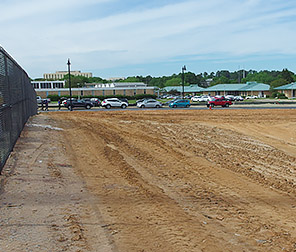 |
| The First Base Building (left) is just down the hill from the Babcock Building. On the right is the spot that will one day be apartments, outside the park near the left-field foul pole. You can see some of the campus’ existing buildings in the background. |
Parking around the ballpark is a little dicey at this point, but that will get better and better as lots are built for the businesses and residents that are coming to the campus. For now, shuttle buses run fans from lots that are about four blocks away.
Although probably still a couple of years away, there will be an apartment building beyond the left field concourse that will be very visible from within the park.
So this is an environment that will be a work in progress for years to come. It’s important to point out, though, that I feel this won’t be a repeat of what has happened in many cities. There are numerous examples of new ballparks that were constructed with the expectation that commercial development will immediately occur around it … and then it doesn’t. Things are happening right now at The Commons at BullStreet, which will make this an even better setting in short order.
Speaking of the surroundings, there is a lovely neighborhood just to the west of the park, across Bull Street. The Cottontown historic district has beautiful canopied streets and attractive homes (below). If you have time, enjoy a walk though it before a game.
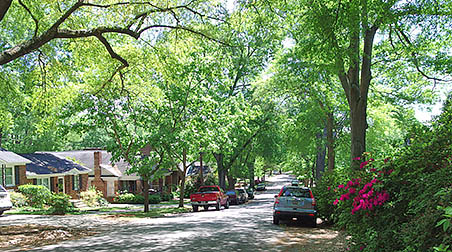 |
| This is Wallace Street in the serene Cottontown neighborhood just west of the ballpark. |
The Exterior
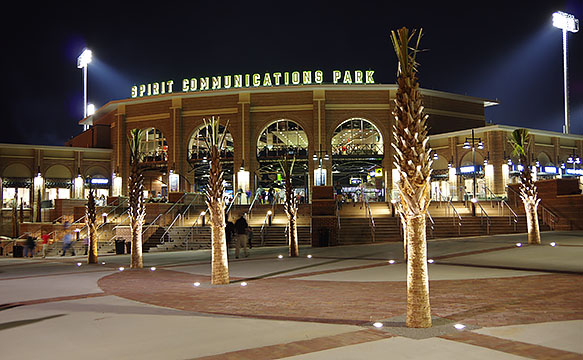
Populous’ Mike Sabatini was the lead designer on Spirit Communications Park. His firm also designed Parkview Field, the home park of the Fort Wayne TinCaps, also owned by Hardball Capital.
All of the renderings I’d seen of Columbia’s park sure made it look like Parkview. Gregory Tucker told me, “We visited Parkview twice, and took the folks from CCEB. We asked lots of questions about what the team thought worked and what didn’t.” So I asked Sabatini if the new park was just a carbon copy of the one in Fort Wayne. After all, Parkview Field is arguably the nicest in Low-A baseball. It’s about as nice as a park can get.
| The designer |
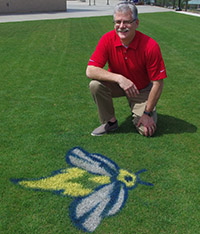 |
| Mike Sabatini of Populous |
“The starting point, from the client’s comfort level, was in fact Fort Wayne,” he revealed. “The distribution of seating (types) was something that Fort Wayne started for all of Minor League Baseball. But Columbia’s park was designed for Columbia. There is a lot more attention to detail, and you see that in the masonry-work. Their entryway is a lot grander, and that’s just one of the things that the sloping nature of the Columbia site caused us to do. In my mind, there are more differences than there are similarities.”
The entry plaza is indeed very grand. When the developer pitched in $1 million for this area, the money was very well spent. There are palmetto trees nearest the street and stairs and stairs and stairs that bring you up to the concourse level, all to account for the 15-foot change in elevation in that part of the site.
The ancient Ensor Building and the brand-new First Base Building make up a lot of the first-base side of the exterior, while the third-base side is a long, straight line that runs along Freed Street. Since most people will enter behind home plate, the third-base side won’t be viewed as frequently … but that doesn’t mean that no effort was given to its look. To the contrary, it is beautiful, with exposed steel arches (painted black) in the windows and protruding black rods to break up the straight masonry.
And that masonry is outstanding, with its varying brick sizes and colors – all to mimic the look of the old buildings on the campus.
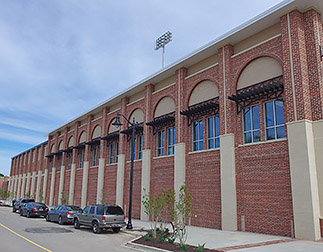  |
Also down the exterior of the third-base line is an interesting feature: batting tunnels on street level, separated from the sidewalk only by netting. “On game days, fans can walk by and actually see players practicing,” Sabatini explained.
 |
Farther down Freed Street, just beyond the left-field footprint of the park, is a large graded area. This is where the apartment buildings and their parking garage will be built in a few years. The solid planning around this is evident.
And it’s at this point in our look around the outside the park that the most intriguing aspect of the exterior can be seen – if you look closely enough. “We call this the Gregory Tucker Memorial Wall,” chuckled Jason Freier, the Fireflies’ owner, as he took me on a tour of the ballpark. He was pointing at a 20-foot-tall retaining wall (below) that supported the concourse and kids’ play area. He explained that he jokingly named the wall after Tucker, who in his role as the City’s project manager came up with an ingenious way to save money, while being environmentally conscious at the same time.
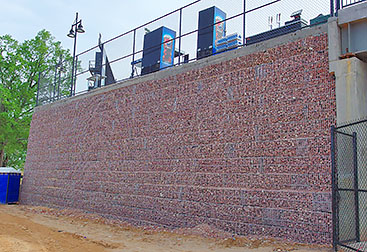 |
Normally, when a sturdy wall like this is needed to hold back tons of dirt and rock, it would require hundreds of thousands of dollars’ worth of concrete. “Tucker suggested we create gabion walls made up of crushed bricks from the campus buildings that had been demolished,” Freier said. “Not only is this really sturdy, it was a responsible thing to do to re-use all of those bricks. Otherwise, it would have cost a fortune to truck all of that debris away and dump it in a landfill. In all, we calculated that it saved the project about $300,000.” And it looks really good, because the colors of the brick fragments (obviously) match the still-standing buildings on the campus.
The perimeter of the park’s property in center field and all the way around to the First Base Building is simply chain-link fencing now. The right-field side between the ballpark and the Babcock Building is graded, ready for the new construction. Sabatini assured me that there will be height restrictions on those new buildings to preserve the view of Babcock and its cupola from within the park.
Now let’s venture inside Spirit Communications Park to see how if it’s as beautiful on the inside as it is on the outside.
